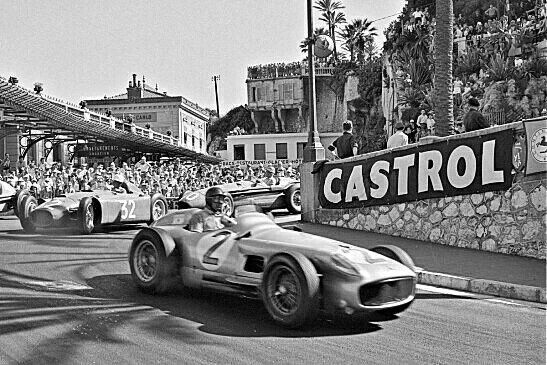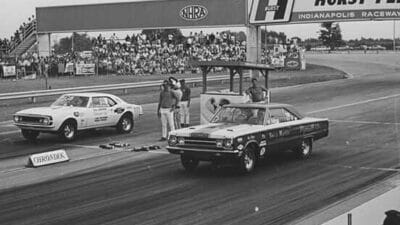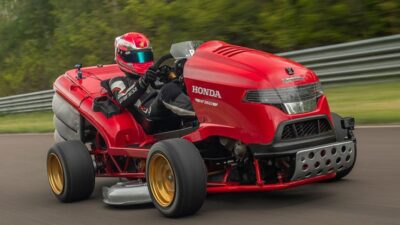Many Formula 1 fans dream of experiencing the raw power and precision of a Grand Prix racing car, but few realize this dream can become reality. Historic F1 cars from past decades are not only available to drive but are actively raced at circuits around the world through specialized driving experiences and vintage racing events. These legendary machines offer enthusiasts the chance to feel what drivers like Ayrton Senna and Michael Schumacher experienced during their championship runs.

Unlike modern F1 cars that remain locked away by teams for years due to technical secrets, older Formula 1 cars have found new life in the hands of collectors and racing enthusiasts. Companies like Williams maintain historic racing departments that keep these engineering marvels in working condition using original drawings and components. From 1960s classics with manual gearboxes to 1990s machines with early electronic systems, each era offers a unique driving experience.
The world of historic F1 car driving spans from affordable track day experiences to million-dollar car purchases for serious collectors. Whether someone wants a single lap behind the wheel or dreams of owning a piece of Grand Prix history, multiple pathways exist to connect with these incredible machines that shaped motorsport history.
Key Takeaways
- Historic F1 cars from the 1960s through early 2000s remain driveable through specialized maintenance programs and vintage racing events
- Driving experiences range from track day sessions costing thousands to purchasing authentic race cars for millions of dollars
- These vintage Formula 1 machines offer unique technical characteristics like manual transmissions and different handling compared to modern Grand Prix cars
What Makes a Historic F1 Car Driveable Today?

Not all historic Formula 1 cars remain functional decades after their racing careers end. Several key factors determine whether these engineering marvels can still roar to life on modern tracks and roads.
Criteria for Roadworthy and Trackworthy F1 Cars
The structural integrity of Formula 1 cars determines their driveable status. These machines were constructed of carbon fibre and other composite materials for durability to withstand extreme racing conditions.
Key structural requirements include:
- Intact monocoque chassis without cracks
- Functional suspension components
- Working brake systems
- Complete aerodynamic elements
The aerodynamics package must remain largely intact for safe operation. Missing or damaged wings create dangerous handling characteristics at speed.
Engine condition poses the biggest challenge. Historic F1 powerplants require specialized knowledge and parts availability. Many cars need complete engine rebuilds before they can run again.
Safety systems must meet current standards for track use. This includes proper seat belts, roll cage integrity, and fire suppression systems.
Ownership and Legal Considerations
Buying an historic F1 car is not for the fainthearted but represents the ultimate motorsport investment. Legal ownership requires proper documentation and provenance verification.
Essential ownership documents:
- Original build records
- Racing history documentation
- Previous ownership chain
- Technical specifications
Most historic F1 cars cannot legally operate on public roads. They lack basic requirements like headlights, turn signals, and registration capability.
Track use requires special permissions and insurance. Many circuits restrict historic F1 cars to specific events or require professional supervision.
Academy drivers are often allowed to drive previous years cars for training purposes, but private ownership involves different regulations.
Restoration and Maintenance Challenges
Williams have a Historic Racing department, which exists to keep their older cars in working order using original drawings, moulds, casts and specialized knowledge.
Major restoration challenges:
- Sourcing period-correct components
- Finding qualified mechanics
- Accessing original technical drawings
- Managing extreme maintenance costs
Parts availability varies dramatically by era and manufacturer. Cars from the 1970s and 1980s often have better parts support than more recent machines with proprietary components.
Labor costs exceed normal automotive work significantly. Specialized F1 mechanics command premium rates for their expertise with these unique machines.
Maintenance schedules demand frequent attention. Historic Formula 1 cars require inspection after every running session and complete rebuilds after minimal mileage compared to road cars.
Iconic Historic F1 Cars Still in Action

Several legendary Formula 1 cars from different eras continue to run at special events and private track days. These machines include championship-winning cars from Mercedes-Benz, Ferrari, and Toro Rosso that shaped racing history.
Legendary Models You Can Experience
Racing enthusiasts can witness some of the most important F1 cars ever built through various programs and events. Many of these vehicles remain in working condition decades after their competitive careers ended.
Historic F1 events like Minardi Day allow private owners to drive their classic Formula 1 cars at famous circuits. These track days feature cars from multiple decades running together.
Notable Historic F1 Categories:
- 1950s Silver Arrows era
- 1970s-1980s turbocharged machines
- 1990s-2000s V10 and V12 engines
- Modern hybrid era cars
Private collectors often purchase retired F1 cars and maintain them for special occasions. The cars require significant investment for both purchase and ongoing maintenance costs.
Juan Manuel Fangio’s Mercedes-Benz W196
The Mercedes-Benz W196 dominated the 1954 and 1955 Formula 1 seasons under Juan Manuel Fangio’s skilled driving. This silver machine won eight out of twelve Grand Prix races during those two seasons.
Mercedes-Benz built the W196 with advanced engineering for its time. The car featured a lightweight space frame chassis and fuel injection system that gave it a competitive advantage.
W196 Technical Specifications:
- Engine: 2.5-liter straight-8
- Power: 257 horsepower
- Weight: 630 kg
- Top Speed: 180 mph
The W196 exists in both streamlined and open-wheel versions. Mercedes-Benz still owns several examples that occasionally appear at historic demonstrations.
Fangio used this car to secure his second and third world championships. The W196’s success helped establish Mercedes-Benz as a dominant force in motorsport.
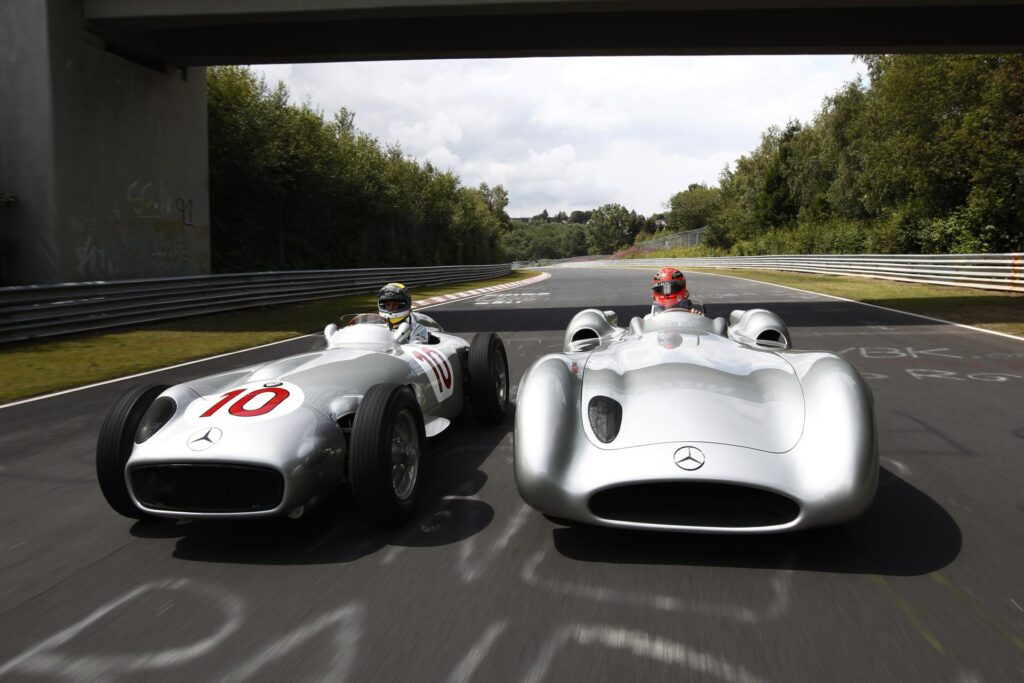
Michael Schumacher’s Championship Ferraris
Michael Schumacher’s Ferrari F2004 and F2002 remain among the most successful F1 cars ever built. These red machines helped Schumacher win multiple world championships during Ferrari’s dominant period.
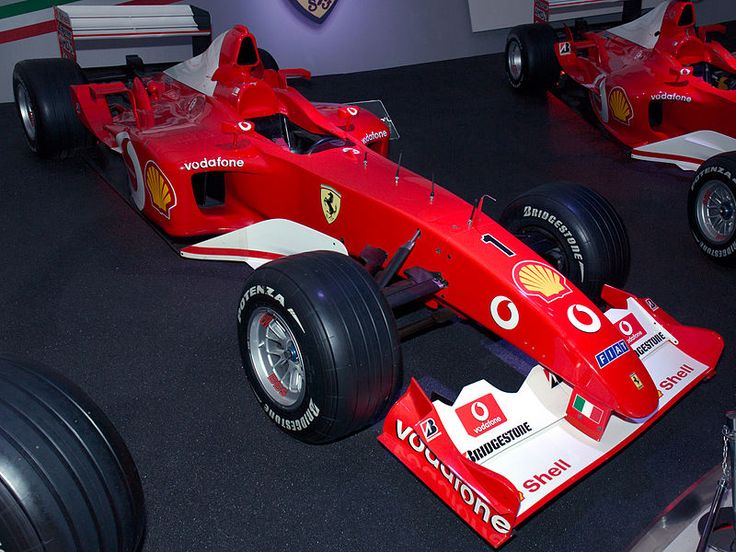
The F2004 won fifteen out of eighteen races in the 2004 season. This car featured a 3.0-liter V10 engine that produced over 900 horsepower at high RPM.
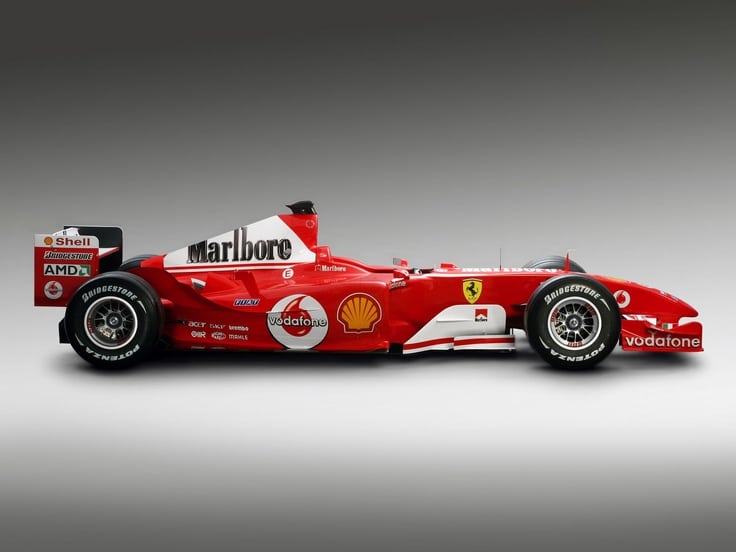
Ferrari maintains several of Schumacher’s championship cars in working condition. The team occasionally runs these vehicles at special events and anniversary celebrations.
- 2002: F2002 – 11 wins from 19 races
- 2004: F2004 – 15 wins from 18 races
- Pole Positions: Combined 20 poles
- Championships: 5 consecutive titles (2000-2004)
These cars represent the peak of Ferrari’s modern F1 success. Their distinctive red livery and screaming V10 engines remain iconic symbols of the sport.
Sebastian Vettel’s STR3
Sebastian Vettel’s 2008 Toro Rosso STR3 achieved one of Formula 1’s greatest upset victories at the Italian Grand Prix. This car marked Vettel’s breakthrough moment in his championship career.
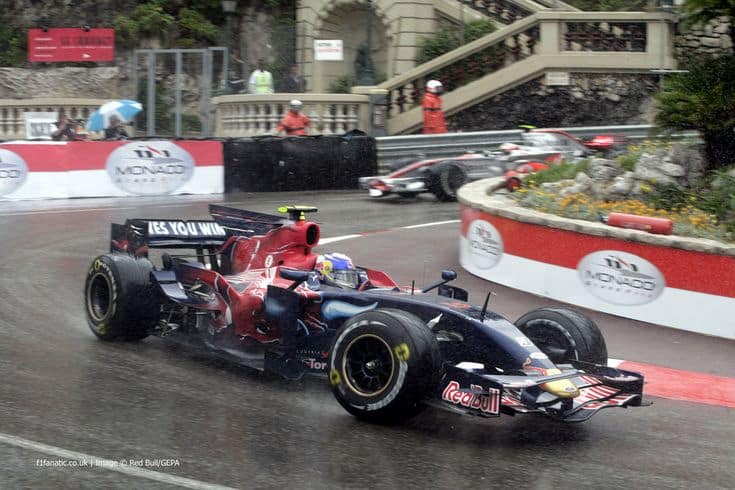
The STR3 featured a Ferrari-supplied V8 engine in Toro Rosso’s distinctive blue and silver livery. Vettel’s wet-weather victory at Monza made him the youngest Grand Prix winner at that time.
Toro Rosso built the STR3 as their third Formula 1 chassis. The car competed during the 2008 season when multiple teams fought for victories due to changing regulations.
STR3 Race Statistics:
- Wins: 1 (Italian GP)
- Podiums: 1
- Points: 39 total
- Best Qualifying: 2nd place
This victory launched Vettel’s career toward four consecutive world championships with Red Bull Racing. The STR3 remains a significant milestone in modern F1 history.
Where and How to Drive Historic F1 Cars

Several specialized companies offer authentic Formula 1 driving experiences at famous circuits worldwide, while museums and historic racing events provide additional opportunities to get behind the wheel of legendary Grand Prix machines.
Private Track Days and Experience Providers
Classic Racing School operates at the historic Charade circuit in France, offering multiple F1-style driving programs. They use specially built Crosslé 90F single-seaters that recreate the 1960s F1 experience.
Available Programs:
- Innes Ireland Experience – Half-day program with three 20-minute sessions (€1,190)
- Jim Clark Experience – Full-day program with six 20-minute sessions (€2,090)
- Chris Amon Experience – Advanced full-day with seven sessions and data analysis (€2,790)
- Jackie Stewart Experience – Two-day program with thirteen sessions (€4,640)
All packages include professional coaching, racing equipment, and onboard video footage. The experiences accommodate drivers of any skill level.
LRS Formula provides access to modern Formula 1 cars with the latest generation atmospheric engines. They claim to be the only company worldwide offering this specific type of F1 driving experience.
Several Formula 1 driving experiences operate at multiple locations including Dubai Autodrome, Bovingdon Airfield, Red Bull Ring, and Circuit de Spa-Francorchamps.
Historic Racing Events and Demonstrations
Many historic racing events allow participants to drive period-correct F1 cars during demonstration sessions. These events typically require racing licenses and significant experience.
Formula 1 teams like Williams maintain historic racing departments that keep older cars operational using original drawings and components. This enables authentic driving experiences at Grand Prix circuits.
Historic F1 demonstrations often take place at Silverstone, Spa-Francorchamps, and Suzuka. These events feature cars from different eras competing in separate classes based on age and specifications.
Participants must typically provide proof of racing experience and complete safety briefings before driving historic F1 cars at competitive events.
Museums Offering Driving Experiences
Several motorsport museums worldwide offer limited driving opportunities with their historic Formula 1 collections. These experiences usually occur on private test tracks adjacent to museum facilities.
Museum-based programs focus on education and preservation rather than performance driving. Sessions are typically shorter and more controlled than commercial track day experiences.
Some facilities combine static displays with hands-on driving experiences, allowing visitors to understand both the technical evolution and driving dynamics of historic Grand Prix cars.
Requirements typically include:
- Valid driving license
- Safety equipment rental or purchase
- Insurance coverage
- Age restrictions (usually 18+)
Private collectors also occasionally offer driving experiences through specialized rental programs, though these opportunities are rare and expensive.
Ownership, Costs, and Collecting

Historic F1 cars demand significant financial commitment beyond the initial purchase price, with maintenance costs often reaching six figures annually. Storage requirements include climate-controlled facilities, while specialized insurance policies protect these multi-million dollar investments.
Acquiring a Historic F1 Car
Historic F1 car ownership represents one of motorsport’s most exclusive collecting categories. Buyers typically acquire these vehicles through specialized auction houses, private dealers, or directly from former racing teams.
Price ranges vary dramatically based on several key factors:
Championship Winning Cars: $10-30 million
- 1954 Mercedes-Benz W196 sold for $29.7 million in 2018
- Cars driven by legends like Michael Schumacher command premium prices
Race-Winning Cars: $2-8 million
Non-Winning Race Cars: $500,000-2 million
The most expensive F1 cars sold at auction typically feature documented race history and original components. Provenance documentation proving the car’s racing pedigree significantly impacts value.
Collectors often focus on specific eras. The 3.0-liter era from the late 1960s to mid-1980s offers more accessible entry points while avoiding modern F1’s complex electronic systems.
Maintenance and Spare Parts Availability
Annual maintenance costs typically range from $100,000 to $500,000 depending on usage and car complexity. Modern F1 cars require more expensive upkeep due to sophisticated electronics and carbon fiber components.
Professional restoration services like Williams Heritage car restoration employ former F1 engineers and mechanics. These specialists possess over 150 years of combined Formula 1 experience and maintain access to original technical specifications.
Critical Maintenance Elements:
- Engine rebuilds every 10-15 running hours
- Transmission overhauls annually
- Suspension component inspection after each use
- Carbon fiber bodywork repairs by certified specialists
Spare parts availability varies significantly by manufacturer and era. Mercedes-Benz and Ferrari maintain better parts support for their historic vehicles. Some components require custom manufacturing when originals become unavailable.
Teams like Williams provide comprehensive support packages including technical assistance, logistics coordination, and professional crew support for track events.
Insurance and Storage Requirements
Specialized collector car insurance policies cover historic F1 vehicles with agreed-value coverage typically ranging from $2-5 million annually in premiums. Standard automotive insurance does not adequately protect these assets.
Insurance Considerations:
- Track day coverage requires separate policies
- Transportation coverage for international events
- Agreed-value policies protect against market fluctuations
- Professional appraisals required every 2-3 years
Storage demands exceed typical collector car requirements. Climate-controlled facilities maintain consistent temperature and humidity levels. Professional storage costs range from $5,000-15,000 annually.
Security systems must include 24-hour monitoring, fire suppression, and restricted access protocols. Many collectors utilize specialized motorsport storage facilities that cater specifically to historic race cars.
Transportation requires enclosed trailers with air-ride suspension and tie-down systems designed for low-clearance race cars. International shipping demands customs documentation and professional logistics coordination.
Technical Differences Between Historic and Modern F1 Cars

Historic F1 cars relied on naturally aspirated engines and basic materials like steel and aluminum, while today’s machines use hybrid power units with carbon fiber construction. The evolution from raw power in the 1950s to today’s hybrid technology shows dramatic changes in aerodynamics, safety systems, and electronic controls.
Engine and Chassis Evolution
Early F1 cars used simple naturally aspirated engines with basic fuel systems. The Alfa Romeo Alfetta dominated the 1950s with its 1.5-liter supercharged straight-8 engine, which was built before Ferrari became a constructor.
Historic chassis were made from steel tubing and aluminum panels. These materials made cars heavier but easier to repair. Drivers could fix many problems with basic tools during races.
Modern F1 cars use carbon fiber monocoques that are much lighter and stronger. The chassis weighs about 80 kilograms compared to 150 kilograms for older steel frames.
Today’s hybrid power units combine turbocharged V6 engines with energy recovery systems. These motors produce around 1000 horsepower total. Historic engines made 300-400 horsepower in the 1960s and 1970s.
Key Engine Differences:
- Historic: 3.0L naturally aspirated V8/V10/V12
- Modern: 1.6L turbocharged V6 hybrid
- Historic fuel capacity: 200+ liters
- Modern fuel limit: 110 kilograms per race
Changes in Aerodynamics Over Decades
Early F1 cars had simple, rounded shapes with minimal aerodynamic features. Wings first appeared in the late 1960s as small additions to help cars stick to the track.
The 1970s and 1980s brought ground effect aerodynamics. Cars used shaped floors to create downforce by pulling air underneath the vehicle. This made cars much faster through corners.
Modern aerodynamics are extremely complex with hundreds of small parts. Front wings have multiple elements that direct airflow around the wheels. Rear wings work with diffusers to create maximum downforce.
Advanced aerodynamics and cutting-edge materials help today’s F1 cars generate over 1000 kilograms of downforce at high speeds. Historic cars produced less than 200 kilograms.
Aerodynamic Evolution:
- 1950s-1960s: Basic shapes, no wings
- 1970s-1980s: Ground effect, simple wings
- 1990s-2000s: Complex wings, refined shapes
- 2010s-Present: DRS systems, detailed flow control
Computer simulations now design every surface. Teams test thousands of variations digitally before building parts.
Modern Safety Features Compared to Historic Cars
Historic F1 cars offered minimal protection for drivers. Many used basic seatbelts with thin helmets and simple racing suits. Fuel tanks sat exposed in dangerous locations.
Cockpits were open with low sides that barely protected drivers during crashes. Fire suppression systems did not exist in most cars from the 1950s through 1970s.
Modern safety innovations include carbon fiber survival cells that protect drivers during high-speed impacts. The halo device covers the cockpit opening to deflect debris and protect the driver’s head.
Current F1 cars use six-point racing harnesses with quick-release systems. Drivers wear HANS devices that prevent head injuries during crashes.
Safety Technology Comparison:
- Historic: Steel roll bars, basic fire extinguishers
- Modern: Carbon survival cells, automatic fire suppression
- Historic: Fuel in cockpit area
- Modern: Crash-resistant fuel cells in protected locations
FIA crash tests ensure modern cars meet strict safety standards. Historic vehicles had no standardized testing requirements. Modern cars must survive impacts at 15 meters per second from multiple angles.
Extraction systems now allow medical teams to remove drivers safely within seconds. Historic cars often required cutting tools and long rescue times.
Famous Drivers and Their Impact on F1 Car Legacy

Legendary drivers have shaped Formula 1 history through their exceptional skills and the iconic cars they drove. Juan Manuel Fangio established racing excellence in the sport’s early years, Michael Schumacher redefined what it meant to dominate Formula 1, and Sebastian Vettel represented the modern era’s technical precision.
Juan Manuel Fangio’s Racing Era
Juan Manuel Fangio won five World Championships between 1951 and 1957. He drove for multiple teams including Alfa Romeo, Ferrari, Mercedes-Benz, and Maserati.
His ability to master different cars made him unique. Fangio could adapt his driving style to each vehicle’s characteristics.
Key Cars Fangio Drove:
- Alfa Romeo 159 – Won 1951 championship
- Mercedes W196 – Dominated 1954-1955 seasons
- Ferrari D50 – 1956 championship winner
- Maserati 250F – Final championship in 1957
Fangio’s cars are now worth millions at auctions. The Mercedes W196 he drove sold for $29.6 million in 2013.
His racing approach influenced car development. Teams built cars that could perform well across different track types rather than specializing for specific circuits.
The Formula 1 legends who shaped the sport include Fangio as a pioneer who proved driver skill could overcome technical limitations.
Michael Schumacher’s Dominance
Michael Schumacher won seven World Championships during his career. He transformed Ferrari from strugglers into champions during the late 1990s and early 2000s.
His technical knowledge helped develop superior cars. Schumacher worked closely with engineers to improve aerodynamics, suspension, and engine performance.
Schumacher’s Championship Cars:
| Year | Team | Car Model |
|---|---|---|
| 1994-1995 | Benetton | B194, B195 |
| 2000-2004 | Ferrari | F1-2000, F2001, F2002, F2003-GA, F2004 |
The Ferrari F2002 won 15 of 17 races in 2002. This car became one of the most dominant in F1 history.
Schumacher’s driving style required specific car setups. He preferred cars with sharp front-end response and stable rear sections.
His partnership with designer Rory Byrne created multiple championship-winning vehicles. These cars featured innovative aerodynamic solutions and lightweight construction.
The greatest Formula 1 drivers recognize Schumacher’s ability to extract maximum performance from his machines.
Sebastian Vettel and the Rise of Modern Legends
Sebastian Vettel won four consecutive championships from 2010 to 2013 with Red Bull Racing. His success coincided with advanced aerodynamic regulations and hybrid power units.
Vettel excelled in cars with strong downforce. The Red Bull RB19 and similar designs suited his precise driving style perfectly.
Vettel’s Key Achievements:
- Youngest World Champion at 23 years old
- 39 consecutive points finishes during peak years
- Four straight titles with Red Bull RB6-RB9 cars
His cars featured complex aerodynamic packages. These vehicles used blown diffusers and sophisticated front wing designs.
Vettel’s technical feedback helped Red Bull develop superior chassis balance. His input led to cars that performed well in both qualifying and race conditions.
The modern F1 era benefits from Vettel’s development work. Current cars use similar aerodynamic principles that his teams pioneered.
His legacy includes advancing Formula 1’s technical capabilities while maintaining the sport’s competitive spirit.
Frequently Asked Questions

Many people want to know about driving classic F1 cars but have questions about availability, legality, and costs. Most historic Formula 1 cars require special arrangements and come with specific restrictions for public driving.
What classic Formula 1 cars are available for public driving experiences?
Several race tracks offer driving experiences with Formula 1 cars from the 1980s through early 2000s. These include cars like the Lotus 79, Williams FW14, and McLaren MP4/1.
Companies like Classic Team Lotus and Williams Heritage provide supervised driving sessions. Participants can drive authentic F1 cars on professional circuits under instructor guidance.
Some experiences feature ground-effect cars from the late 1970s and early 1980s. Others include turbocharged machines from the 1980s that defined an era of F1 racing.
Which historic F1 cars are legally drivable on regular roads?
Very few authentic Formula 1 cars meet road safety requirements for street driving. Most F1 cars lack basic safety features like headlights, turn signals, and street-legal tires.
Some companies create road-legal replicas based on F1 designs. These vehicles include necessary safety equipment while maintaining the look and feel of classic F1 cars.
Certain Formula 1 demonstration cars have been modified for road use. These modifications typically include lighting systems, mirrors, and emissions equipment required by local laws.
How can enthusiasts find opportunities to drive vintage Formula 1 cars?
Track day companies at major racing circuits offer F1 driving experiences throughout the year. Silverstone, Brands Hatch, and other famous tracks host these events regularly.
Racing schools sometimes include historic F1 cars in their advanced programs. Students progress through different vehicle types before reaching Formula 1 level cars.
Private collectors occasionally rent their F1 cars for special events. These opportunities usually require significant driving experience and substantial deposits.
Are there any restrictions on driving historic Formula 1 cars?
All F1 driving experiences require participants to have valid racing licenses or complete safety courses. Most programs mandate helmet use and specific racing suits.
Age restrictions typically start at 18 years old for F1 experiences. Some companies require participants to be 21 or older due to insurance requirements.
Height and weight limits apply because F1 cockpits have fixed dimensions. Drivers must fit safely within the car’s safety cell and reach all controls properly.
What maintenance considerations should be taken into account when driving a historic F1 car?
Historic F1 cars require specialized mechanics familiar with period-specific technology. Many parts are no longer manufactured and must be custom-made or rebuilt.
Engine rebuilds can cost tens of thousands of dollars for older F1 cars. Transmission and suspension components also require expert attention and expensive materials.
Tire availability presents challenges since modern racing tires may not suit vintage suspension designs. Some cars need period-correct tire compounds for proper handling.
How do the driving experiences of modern F1 cars compare to those of their historic counterparts?
Modern F1 cars are physically easier to drive but harder to keep on track due to instant power delivery from hybrid systems. Historic cars provided more predictable power curves.
Older F1 cars from the 1970s and 1980s required more physical strength to operate. They lacked power steering and demanded greater driver input for basic control.
Ground effect cars from the late 1970s provided incredible cornering speeds but could lose downforce suddenly. This made them challenging but rewarding for experienced drivers.
